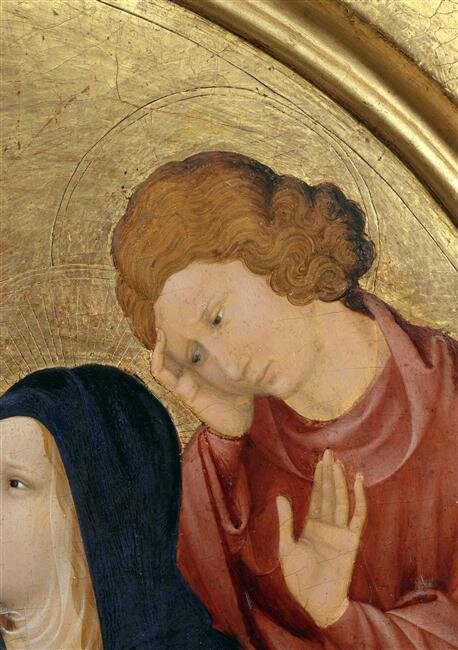Large round Pietà by Johan Maelwael leaving Paris for the first time in 55 years
La Grande Pietà ronde, attributed to Johan Maelwael (Jean Malouel). (Nijmegen, c. 1370 - Dijon, 1415), c. 1400. © 2009 Musée du Louvre / Erich Lessing.
AMSTERDAM.- From 6 October 2017 until 7 January 2018 the Rijksmuseum honors the first Northern Netherlandish painter: Johan Maelwael
This uncle of the legendary Limbourg Brothers was active as a versatile, pioneering and productive artist at the courts of the Dukes of Guelders and Burgundy around 1400. The show is organized with the exceptional support of the Musée du Louvre that lends Maelwael’s most famous painting La Grande Pietà ronde that has never left Paris since 1962. The panel will make its first appearance in the Netherlands.
Medieval splendour
For the first time, paintings attributed to Johan Maelwael (Jean Malouel, Nijmegen, c. 1370 - Dijon, 1415) and his workshop will be exhibited alongside medieval art treasures, illuminated manuscripts, precious metalwork and sculpture. Paintings attributed to Johan Maelwael and his contemporaries Jean de Beaumetz, Colart de Laon and Henri Bellechose will be juxtaposed not only with the sculptures by André Beauneveu, Claes Sluter and Claes van Werve, but also with the richly decorated illuminated manuscripts of the famous Limbourg brothers.
Exceptional loans
The absolute centrepiece of the exhibition will be La Grande Pietà ronde from the collection of the Musée du Louvre. This Lamentation of Christ, painted for Philip the Bold, Duke of Burgundy (1363-1404), combines the subject of the Suffering Christ with that of the Holy Trinity. The round panel, preserved in a pristine condition, is one of the rare works attributed to Johan Maelwael to have survived. Purchased by the Louvre in 1864 it has never left Paris since 1962. Other exceptional loans will come from, among others, the Bibliothèque nationale de France in Paris, The Cleveland Museum of Art, the Royal Library of Belgium in Brussels and The Metropolitan Museum of Art in New York.
Court painter
Having begun as a heraldic painter at the court of the Dukes of Guelders in Nijmegen, Johan Maelwael predominantly worked for nearly twenty years as a court painter and valet to the Burgundian dukes Philip the Bold and his successor, John the Fearless. At the Burgundian court, Maelwael decorated flags, banners and armour, painted large murals, religious paintings and small devotional works, and colored and gilded sculpture.. Around 1400 Johan Maelwael introduced his three talented nephews, Herman, Paul and Johan de Limbourg, as miniature painters in France.
Catalogue
The exhibition will be accompanied by a catalogue with contributions of Rob Dückers, Elisabeth Ravaud, Pieter Roelofs, Victor Schmidt, Matthias Ubl, a.o. Design: Irma Boom | English ISBN 978-94-6208-379-0 | €35 | 216 p | 21,5 x 28 cm | 175 ills.
Attribué à Jean Malouel, Pitié de Notre Seigneur, dit "la grande Piétà ronde", détail, c. 1400, Musée du Louvre. Photo © RMN-Grand Palais / Christian Jean / Jean Schormans
Attribué à Jean Malouel, Pitié de Notre Seigneur, dit "la grande Piétà ronde", détail, c. 1400, Musée du Louvre. Photo © RMN-Grand Palais / Christian Jean / Jean Schormans
Attribué à Jean Malouel, Pitié de Notre Seigneur, dit "la grande Piétà ronde", détail, c. 1400, Musée du Louvre. Photo © RMN-Grand Palais / Christian Jean / Jean Schormans
Attribué à Jean Malouel, Pitié de Notre Seigneur, dit "la grande Piétà ronde", détail, c. 1400, Musée du Louvre. Photo © RMN-Grand Palais / Christian Jean / Jean Schormans

/https%3A%2F%2Fprofilepics.canalblog.com%2Fprofilepics%2F1%2F0%2F100183.jpg)
/https%3A%2F%2Fstorage.canalblog.com%2F03%2F02%2F119589%2F96711876_o.jpg)
/https%3A%2F%2Fstorage.canalblog.com%2F11%2F31%2F119589%2F94773502_o.jpg)
/https%3A%2F%2Fstorage.canalblog.com%2F20%2F83%2F119589%2F94772815_o.jpg)
/https%3A%2F%2Fstorage.canalblog.com%2F26%2F72%2F119589%2F75604929_o.jpg)
/https%3A%2F%2Fstorage.canalblog.com%2F59%2F60%2F119589%2F26458628_o.jpg)








/http%3A%2F%2Fstorage.canalblog.com%2F65%2F82%2F119589%2F94461163_o.jpg)
/http%3A%2F%2Fstorage.canalblog.com%2F75%2F34%2F119589%2F117664435_o.png)
/image%2F1371349%2F20240418%2Fob_ac5c4c_telechargement.jpg)
/image%2F1371349%2F20240418%2Fob_709b64_304-1.jpg)